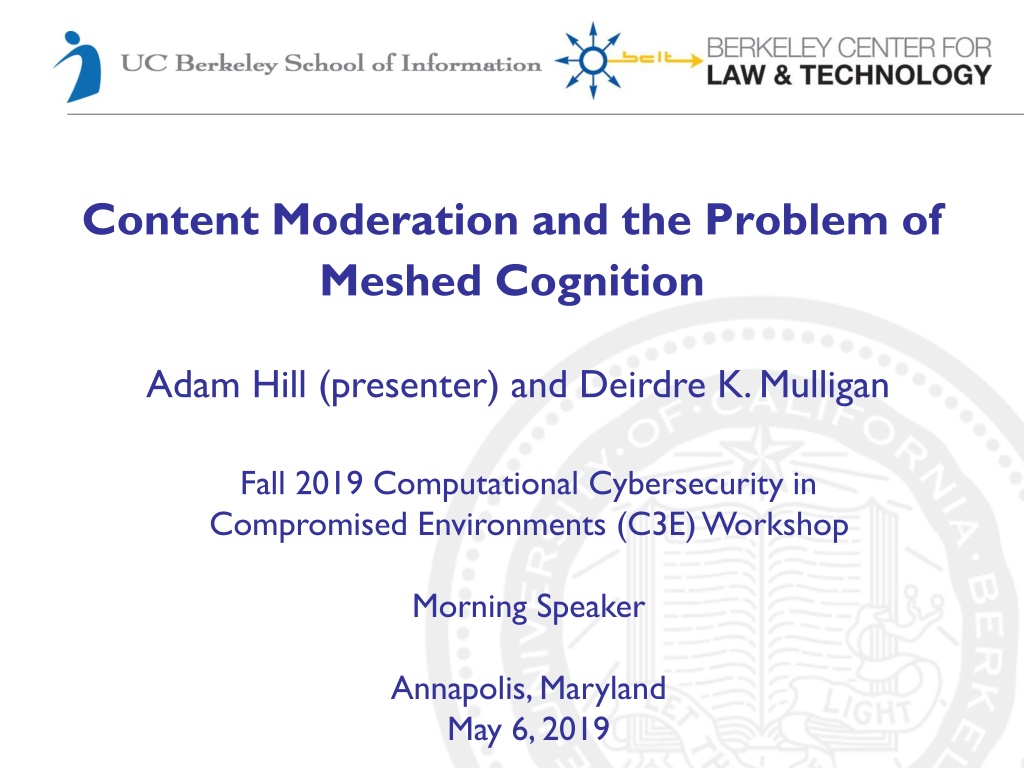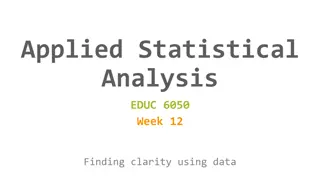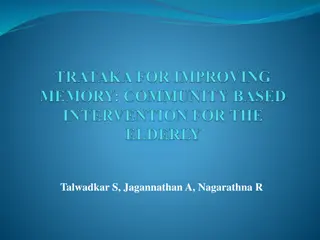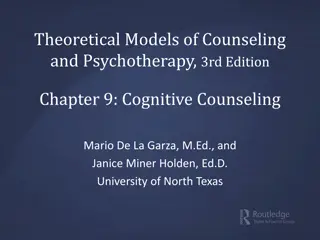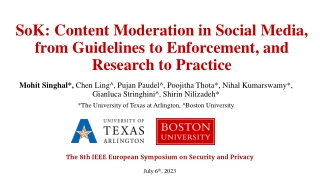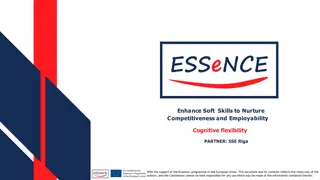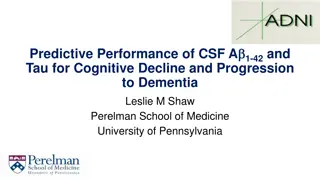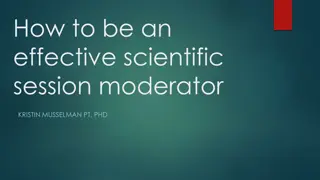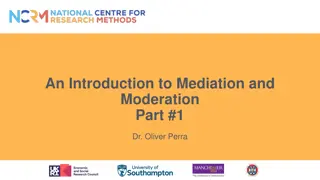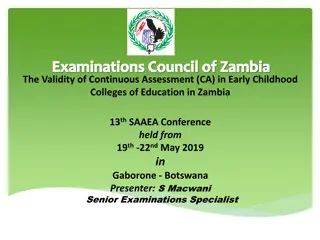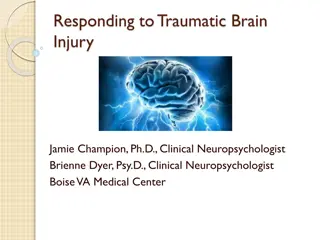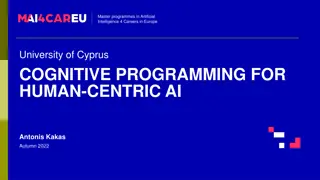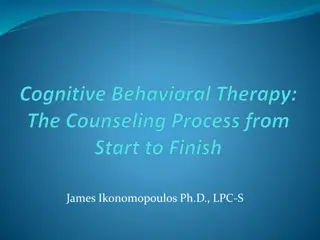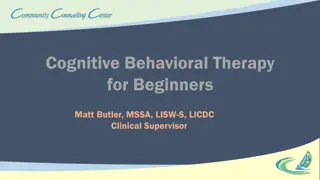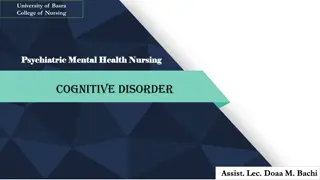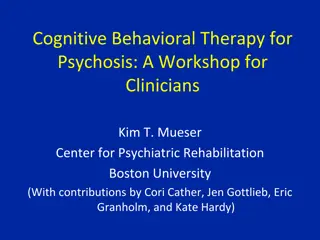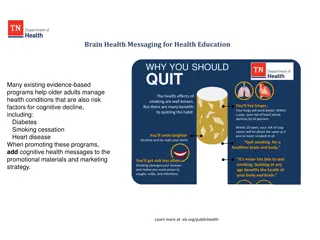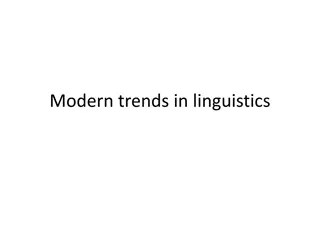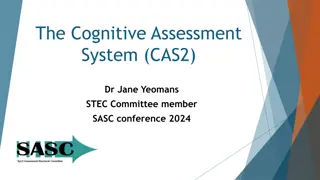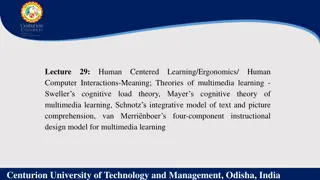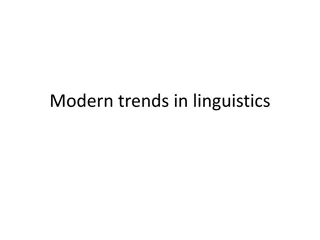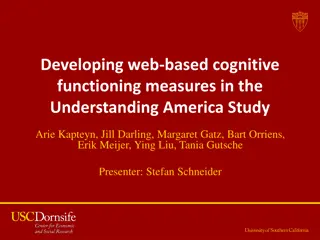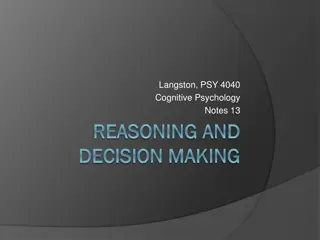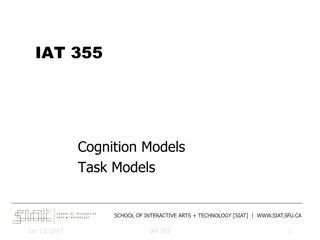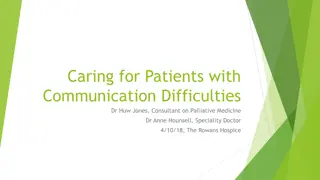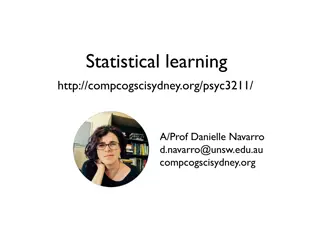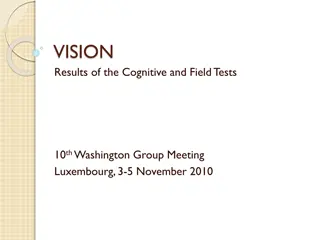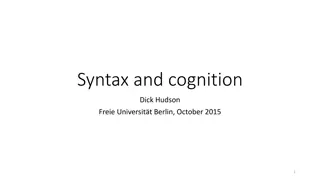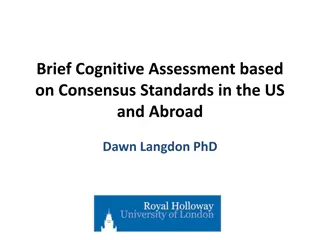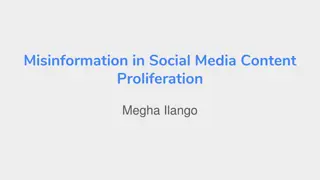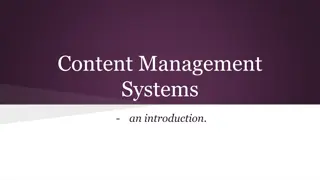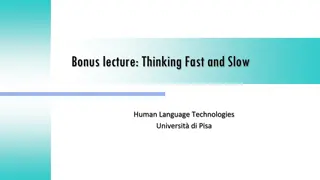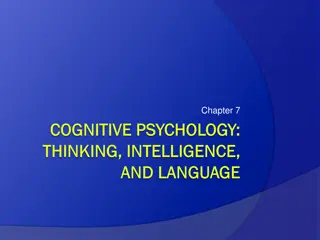Challenges in Content Moderation and Cognitive Performance
The content discusses the impact of global social information environment and human-centric cyber vulnerabilities on cognitive performance. It emphasizes the erosion of cognitive abilities due to biases, diminished critical thinking, and exposure to covert exploitation. The dynamics are observed in social networking sites where platform moderation plays a crucial role in limiting toxic content. Individual-level interventions aim to enhance decision-making by reducing biases through actions like flagging, rating, muting, and blocking.
- Content Moderation
- Cognitive Performance
- Global Social Information Environment
- Cyber Vulnerabilities
- Social Networking
Download Presentation

Please find below an Image/Link to download the presentation.
The content on the website is provided AS IS for your information and personal use only. It may not be sold, licensed, or shared on other websites without obtaining consent from the author. Download presentation by click this link. If you encounter any issues during the download, it is possible that the publisher has removed the file from their server.
E N D
Presentation Transcript
Content Moderation and the Problem of Meshed Cognition Adam Hill (presenter) and Deirdre K. Mulligan Fall 2019 Computational Cybersecurity in Compromised Environments (C3E) Workshop Morning Speaker Annapolis, Maryland May 6, 2019
What does optimal cognitive performance look like? Direction of fit Beliefs match the world World matches our desires Expected utility theory State of world Preferences Outcomes
Global Social Information Environment (GSIE) is Eroding Cognitive Performance Biases in reasoning Diminishing critical thinking and analysis Exposing individuals to covert exploitation Net effect Slack in DoF Bad decision-making, bad outcomes
Human-centric cyber vulnerabilities resulting... from decreased cognitive performance Too much or too little trust Confusion around identity Too much or too little deference to authority and expertise from violations of norms (ethical, social) Degradation of norms of confidentiality, integrity, and access (CIA)
Where are these dynamics playing out? Shape human experience on a global scale Social Networking Sites (SNS) Key attributes of SNS Facebook YouTube Reddit All social media platforms moderate Platform politics User profiles Public lists of friends (viewable) Most or all actions public by default
SNS platform moderation as our point of leverage Widespread dissatisfaction with SNS Awareness of the political, social, and economic costs of harassment, fake news, and otherwise anti-social content and behavior Platforms are under pressure to limit the creation, spread, and influence of toxic content
Designed around individual-level interventions. Goal: improve individual cognition by reducing biases and improving decision-making Actions: Flagging, rating, muting, blocking Conventional Approach to SNS Moderation Current, ongoing practice at SNS
Conventional Approach to SNS Moderation Two categories of intervention Informational nudges Give users the info they need to succeed Exposure control Proprietary combinations of background behavioral signals (e.g., repeated sign ups from the same IP address) and human moderation to reduce exposure
Three Types of Individual-Level Nudges Nudge type Example Cognitive effect Normative contestability Low Informational Google Maps Adds info about which individual reasons Forces individual to grapple with salient fact Salience-exploiting Thermostat that shows energy usage Medium E.g., that they are using a ton of energy Covertly motivates action or reasoning Bias-exploiting Graphic warnings on cigarette packs High
The Problem with the Conventional Approach Wrong unit of analysis Conceive of the problem as one of individual cognition Thus, doomed to fail These approaches have ignored group cognition Powerfully impacts individual cognition Individual cognition often subordinate to group cognition Operates at scale
Our proposal: ModerateMeshed Cognition SNS should turn their attention to Meshed Cognition MC must be successfully managed before individual-level interventions will work
Is MC new? Prior to advent of SNS, MC arose in limited set of conditions Teams, exercise groups, families, close friendships These groups cooperated through norms that were typically non-dominant in social life Norms of responsiveness, commitment, and support to group members
Meshed Cognition SNS affordances lead to MC dominance People end up in loosely organized non-hierarchical groups without really intending to Become saddled with these new norms that govern their behavior These norms make individual-level interventions ineffective, because they subordinate individual interests to group interests from the start Need new interventions that reflects this new SNS- driven cognitive framework
How do these group think? Corporation: hierarchical rules MC: just-in- time flexibility Mob: uncoordinated aggregation
Analog to Meshed Wireless Networks When MC emerges, individual cognition operates like nodes in a mesh wireless network Individual nodes utility functions maximize the group s connectivity over their own Nodes sacrifice in order to offer (R, S, C) to the group in order to achieve a larger end Where meshed wireless networks push spectrum across a group of nodes, individuals push a bundled set of beliefs and desires about the world across a network. Where meshed wireless networks use certain protocols to communicate, individuals push these bundled sets of beliefs and desires through meshing norms. They are, in a sense, the communication protocols of meshed cognition
Hypothesis: Meshed Cognition MC is driving the crisis in cognition more than failures of individual reasoning SNS accelerate the creation and scale of MC In turn, MC accelerates the types of cognitive failures that lead to cyber vulnerabilities Direction of the bias is uniform across groups As opposed to individual-level bias, in which errors aren t always correlated Individual cognitive errors "wash out"
How MC Flourishes on SNS Individuals use SNS to assemble publics They are platforms of association, not just communication SNS drive users to see their own social agency in terms of collective goals, which can best be realized through technical affordances provided by SNS Unlike other communication technologies, such as email or phone calls, which are primarily used as 1-to-1 or one-to-many modes of communication, SNS are default to group communication Creates an active ongoing relationship between the user and the community. Default posture is one of support for a user s network. Exit can occur, but typically requires something akin to a permanent withdrawal from the network.
How MC Flourishes on SNS New SNS users must decide where to channel own preexisting beliefs and preferences. Almost by necessity, it will be toward high status personas who represent groups with collective goals. Users convey passive support for their (now) shared goal. Collective goals reinforced relentlessly by algorithms that move high controversy posts to the top of users timelines. Shared goals and discourses become largely stable and persistent across a user s platform experience.
MC Defeats Current Moderation Strategies Premise of informational nudges is that they engage a user s System 2 cognition, which involves the slow, deliberate processing of information. Assumption: the educating information helps the subject get where she wants to go. If the educative nudge is designed to hinder the success of a shared project supported by MC norms, however, the individual s investment in the shared goal will blunt the impact of the nudge. Individual has already decided where they want to go
Research Opportunities and Questions We offer a simple yet robust causal structure that links the social meaning of groups projects with individual decision-making biases. While we illustrate our theoretical account here with examples, our theory is ripe for experimental testing Future work Experimental Testing how quickly groups establish MC in the lab Testing what affordances contribute to malicious or benign MC Network analysis Can we use techniques of network analysis to identify MC groups before they form?
Research Opportunities and Questions Pressing questions What strategies can SNS use to stop formation of malicious MC? How do we distinguish malicious MC from benign MC ex ante? In what ways does influencing MC through SNS affordances raise normative concerns, such as coercion or paternalism?
This work is supported by the following grants NSF INSPIRE: Value-Function Handoffs in Human-Machine Compositions SES 1650589 UC-Berkeley Center for Long-Term Cybersecurity: Ride Free or Die: Overcoming Collective Action Problems in Autonomous Driving Governance, CY2018, #42
A1: The three norms of MC (Meshing Norms) A distinctive set of norms emerge when individuals coordinate behavior non-hierarchically Three key norms for MC Responsiveness Willingness to be flexible in response to co-coordinators Support Willingness to lend material support (time, money, energy) where it will help achieve the group goal Commitment Willingness to subordinate other important ends to the group s goal(s) These norms tend to produces biases in individuals reasoning and decision-making. The resulting reasoning is what we refer to as MC
A2: More on the analogy to meshed networks The way in which meshing norms are instantiated among a group of individuals can strongly shape the meaning of information shared among and processed by the network. As network protocols can shape and re-shape the information that passes through a network, so too can meshing norms shape the information that passes among users in a social network.
A3: Cyber vulnerabilities created by MC Asset Management The data, personnel, devices (NIST cybersecurity framework) To the extent cyber vulnerabilities can be generated through cognitive degradation, risk exists Mitigation strategies Strengthening culture within organization to help combat association with hostile groups
A4: Two types of human cognitive bias These apply even in the best circumstances Probably irreducible feature of human life We can make improvements on the margin Judgment errors Errors that cause there to be a reduction in the fit between belief and world. Confirmation bias: regard evidence that matches world view more favorably than evidence which does not match their world view, even when the latter is stronger. Preference errors Prospect theory: individuals have inconsistent desires about how the world should be. In this case, the bias leads individuals to fail to intend to make the world fit their desires.
